The Best Guacamole Recipe is fresh, simple, and made with high-quality, simple ingredients like avocado, onion, tomatoes, lime juice, garlic, and cilantro. Creamy, delicious, and easy to make, serve it at your next party, or enjoy it with tacos, nachos, or tortilla chips. Naturally gluten-free, dairy-free, and vegan.
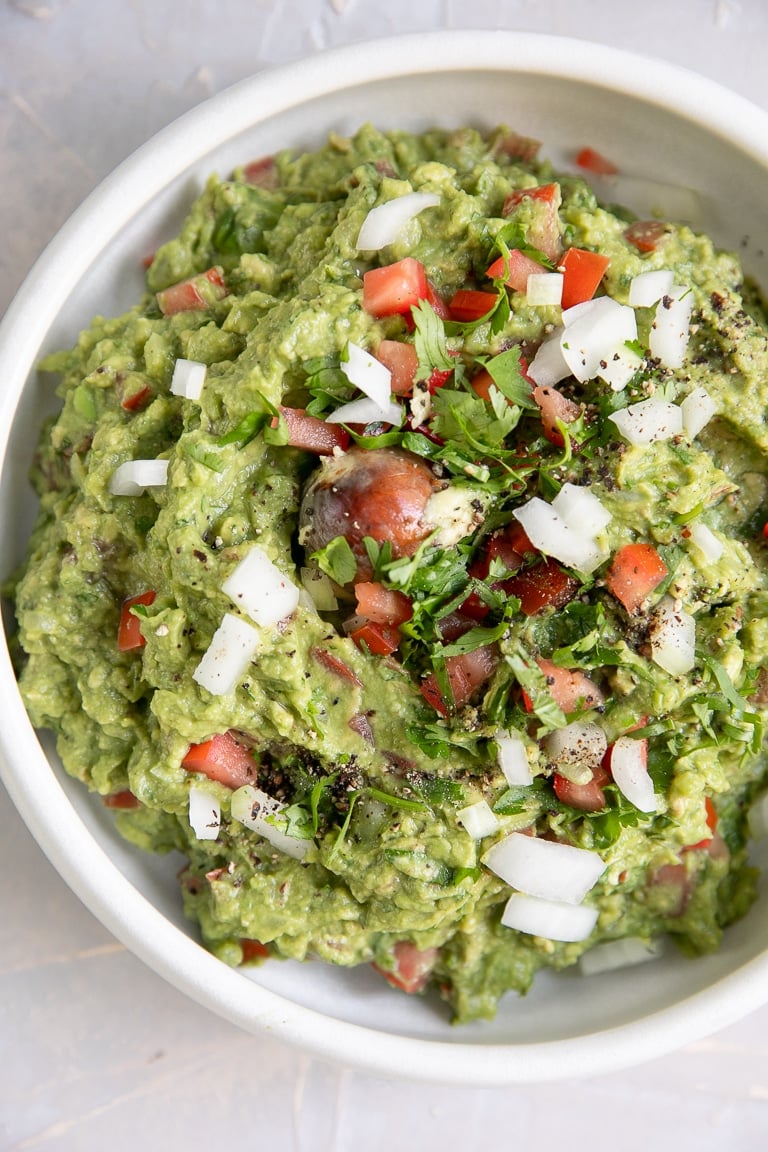
Best Guacamole Recipe
If you’re here, I’m guessing you’re a pretty big fan of guacamole – or guac as it’s often called here in the States. Fresh, delicious, and uncomplicated, it’s easy to understand why even those who dislike avocados love guacamole.
Born and raised in southern California, guacamole was a huge part of my growing up (even if I didn’t really learn to love it until my teen years). Now, it’s my go-to restaurant appetizer, snack, and must-have party essential.
In this post, I will share with you my all-time favorite homemade guacamole recipe, how to make it, and answer all the other guacamole questions you’ve been dying to know.
What is Guacamole?
In its simplest form, guacamole is an avocado-based dip or spread that was first developed by the Aztecs in what is modern-day Mexico. The name comes from the Aztec word, āhuacamolli, which translates to “avocado sauce”.
Guacamole, as we know it, typically includes lime or lemon juice, salt, and additional ingredients such as garlic, onion, cilantro, jalapeño or other chili peppers, and tomatoes. It has a creamy, smooth texture and a rich, mildly tangy taste. It is often served as a dip with tortilla chips or as a topping for tacos, burritos, nachos, and various other Mexican dishes.
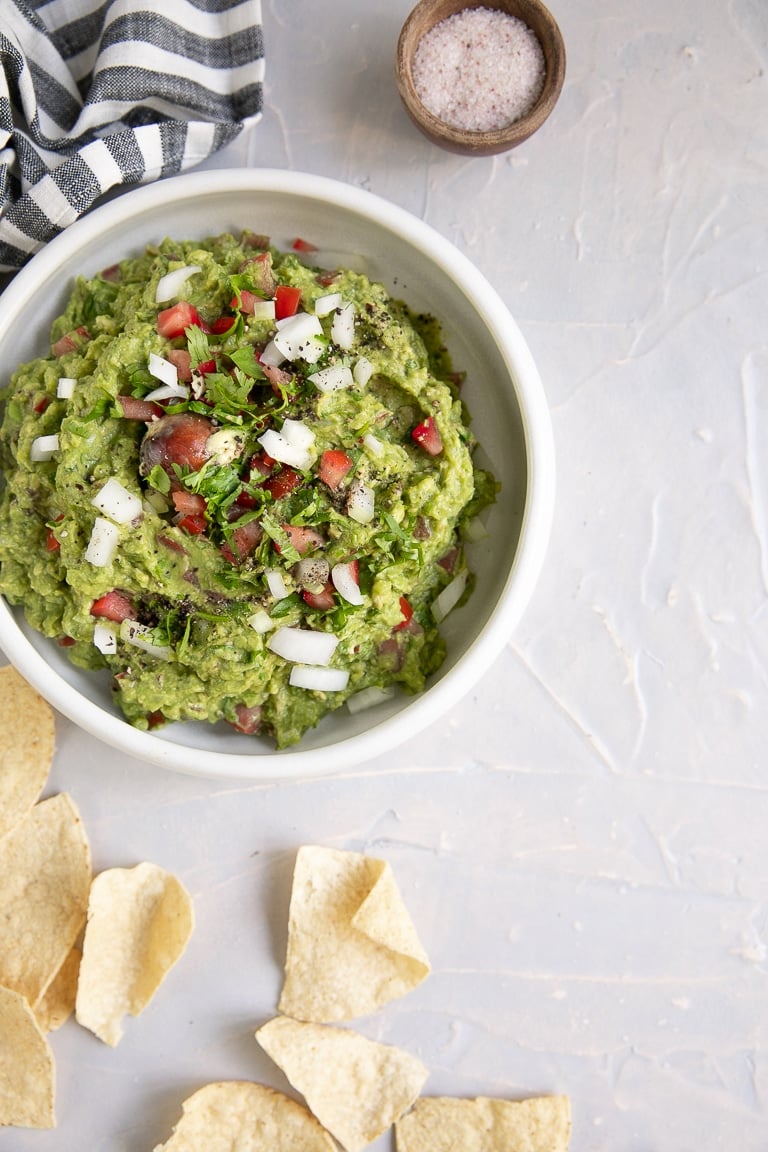
Homemade Guacamole Ingredients
- Authentic guacamole – Avocado, jalapeño, cilantro, onion, lime juice, and salt.
- Popular additions – Garlic and diced tomato. Of course, this is all about personal preference.
- Ingredients that should be left out – sour cream and cream cheese. Yes, you guys, you can add these things if you really want to, but the whole point of guacamole is that it tastes fresh with minimal ingredients.
Ok, so what’s going on in this guacamole recipe? Is my recipe authentic?
Well, mostly, yes. Except for the tomatoes. Fortunately, you can easily leave out the tomatoes if you don’t care for them. Besides, after visiting Mexico earlier this year, I would argue that not all guacamole recipes in Mexico are free of tomatoes… I know this because I ate a bowl.
- Avocados – you need ripe avocados to make guacamole. That doesn’t mean you want brown, rotting ones, so get ’em before they go bad.
- Onion – I love to use white onion for dips and salsa. You may also use red onion if that’s what you have available.
- Cilantro – If you hate cilantro, you can always leave it out. But that definitely isn’t recommended.
- Fresh lime juice – Freshly squeezed from real limes will taste the best. Add more or less, to taste.
- Tomatoes – I love a little seeded and diced Roma tomato in my guacamole. As I mentioned above, tomatoes are completely optional.
- Salt + Pepper – You will need to add some salt and black pepper to your dip to help bring out the flavors. How much, however, depends entirely on you. I recommend starting with less and adding more as you go along.
- Garlic – Totally optional. However, should you add garlic, freshly minced garlic is best as powdered garlic can be somewhat overwhelming. Also, take care not to add too much. I added 1 clove and it was just right.
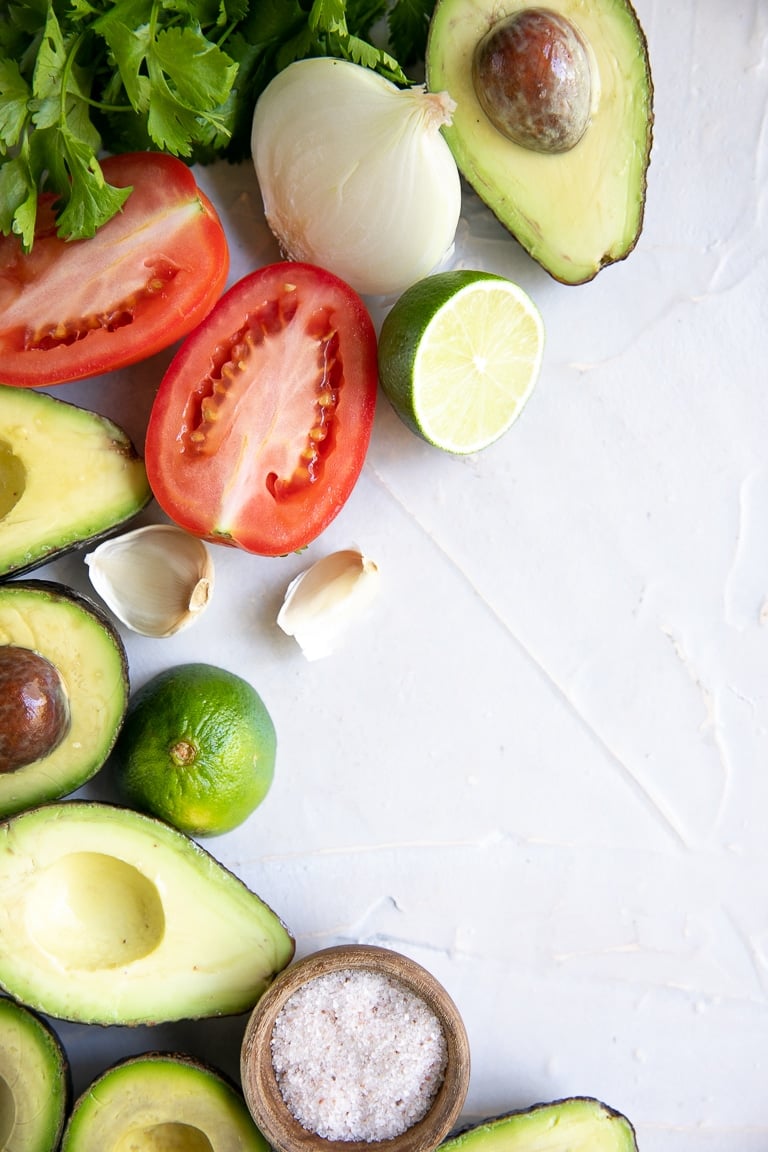
How to Make Guacamole
Start by slicing each avocado in half and carefully remove the pit. Scoop the avocado flesh into a medium bowl with lime juice and a pinch of salt. Mash the avocadoes using the back of a fork until desired consistency is reached (I prefer somewhat chunky guacamole, but feel free to mash away if you like yours nice and smooth).
Mix in the diced onion, tomatoes, garlic, cilantro, and fresh ground black pepper. If desired, mash the onion and tomatoes with the avocado to better release their flavors.
Taste your guacamole and season as needed.
- For a spicier guac recipe, add some diced jalapeño or serrano peppers.
- Add more lime juice for a tangier (and less thick) guac.
- For an extra chunky dip, top with extra diced tomato and onions.
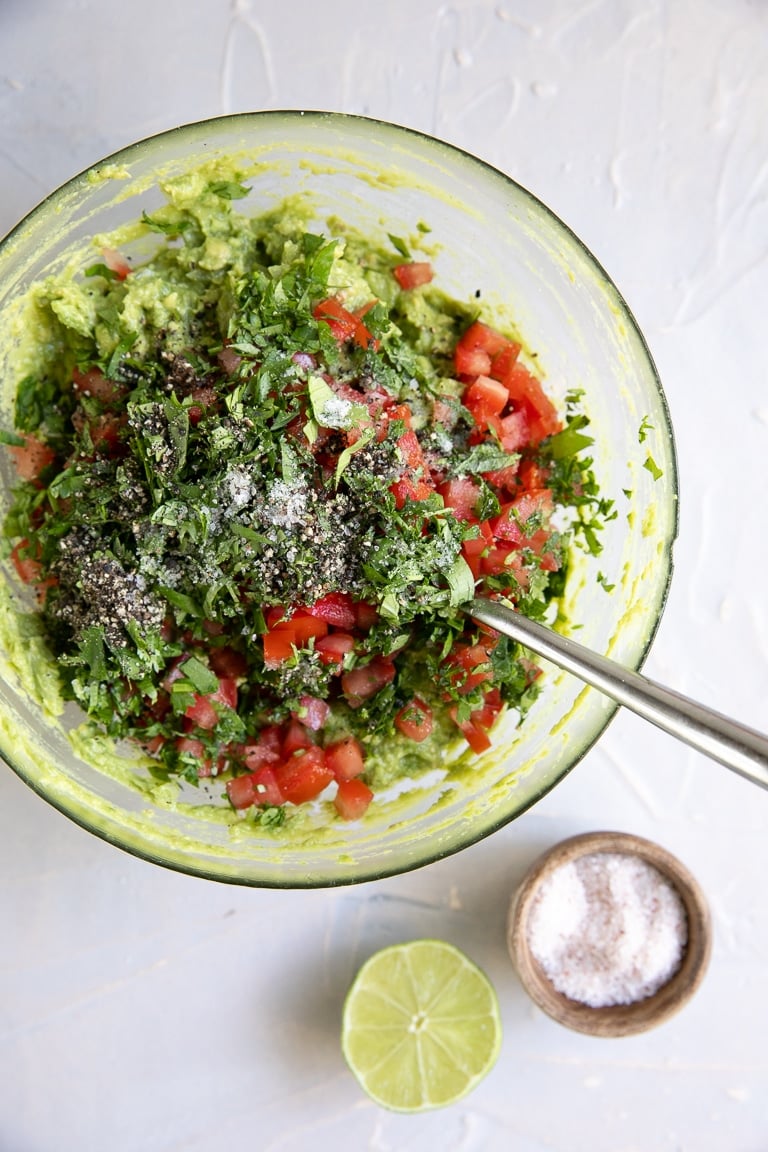
How to Keep Guacamole From Turning Brown
Avocado and oxygen have one of the craziest love-hate relationships in existence. Avocados need oxygen to grow, but the moment it’s cut open and exposed to air, it starts to oxidize and turn brown.
So, How do we keep avocados from turning brown? Water.
- Transfer any leftover guacamole to a container or jar that comes with a tight-fitting lid.
- Pack the guacamole tightly, tapping the sides to remove any air bubbles.
- Drizzle in a thin layer of cool water (approximately 1/2 inch), covering the entire surface of the guacamole. Guacamole is so dense that the water won’t seep through.
- Cover and seal the lid tightly and transfer to the refrigerator for up to 3 days.
- When ready to eat, remove the lid and carefully drain off the layer of water. Re-stir your guacamole and enjoy!
What solutions do not work?
- Avocado pits. Big fat no. Yes, I added it to the bowl here for decoration, but it in no way helps keep the guac green.
- More lime juice. Another no. Sure, it helps maintain freshness for a bit longer, but a day…two days? Not in my experience.
- Plastic wrap directly on top of the guacamole. Works temporarily, maybe a day or so, but do we really want to use more plastic?
Can You Freeze Guacamole
Yes. Guacamole can be frozen for up to 3 months.
- Choose an airtight, freezer-safe container or resealable plastic freezer bag. You can also use individual small containers or bags if you prefer to freeze in smaller portions.
- If using a container, press a piece of plastic wrap directly onto the surface of the guacamole to minimize air exposure, which can cause browning.
- Seal the container or bag, removing as much air as possible.
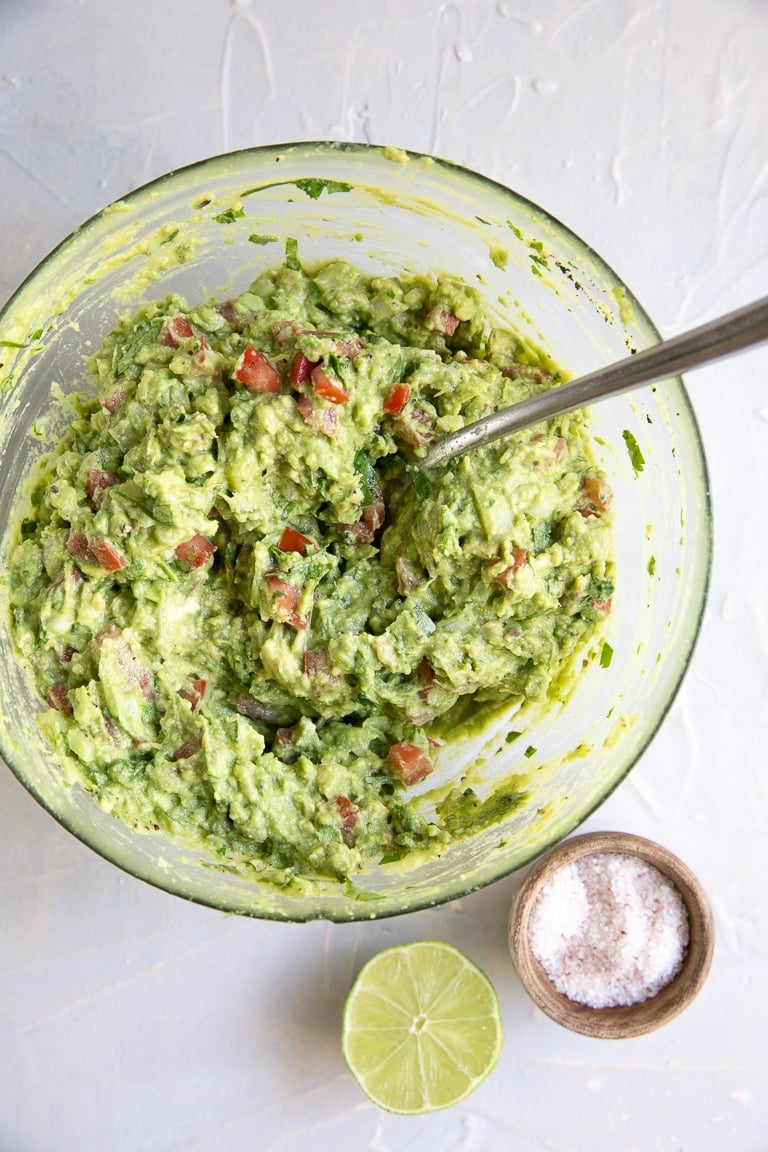
Tips and Tricks
- Make sure to dice your onion and tomato small and in approximately equal sizes to not overpower the dish.
- Only use fresh ingredients. This is especially important for lime juice.
- Have fun with it! Just because this recipe only has a handful of ingredients, that doesn’t mean you can’t add more. Other delicious additions include,
- Fruits – pomegranate arils and mango are my two faves, but pineapple and peaches would also go great.
- Veggies – chopped bell pepper and jicama give an amazing crunch.
- Cheese – When I was in Mexico, one place served their guacamole with chunks of queso fresco (similar to mozzarella). It was amazing.
- Greek yogurt, sour cream, or cream cheese – I know I said not to, but if you really like a creamier guac.
- Make sure your avocado is ripe but not rotten for the best flavor.
- Prepare your guacamole recipe for your own preferences– not based on what’s traditional versus non-traditional.
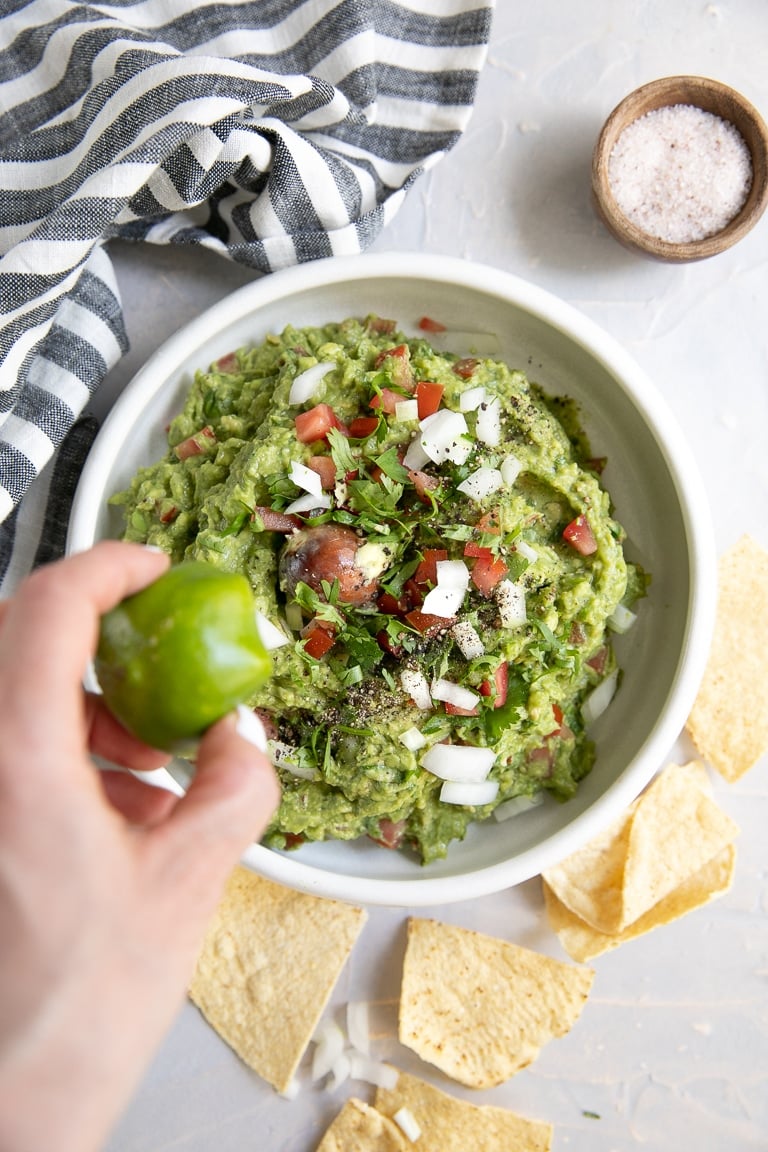
More Mexican Recipes
- Mexican Mole Sauce Recipe (Chicken Mole)
- Albondigas Soup Recipe (Mexican Meatball Soup)
- Paloma Recipe (How to Make a Paloma Cocktail)
- Easy Homemade Salsa Recipe; How to Make Salsa
- Mexican Birria Recipe (How to Make Birria)
- Pozole Rojo (Red Posole) Recipe
- Beef Empanadas Recipe
- Carnitas Recipe (Mexican Slow Cooker Pulled Pork)
If you try making this Guacamole Recipe, please leave me a comment and let me know! I always love to hear your thoughts.
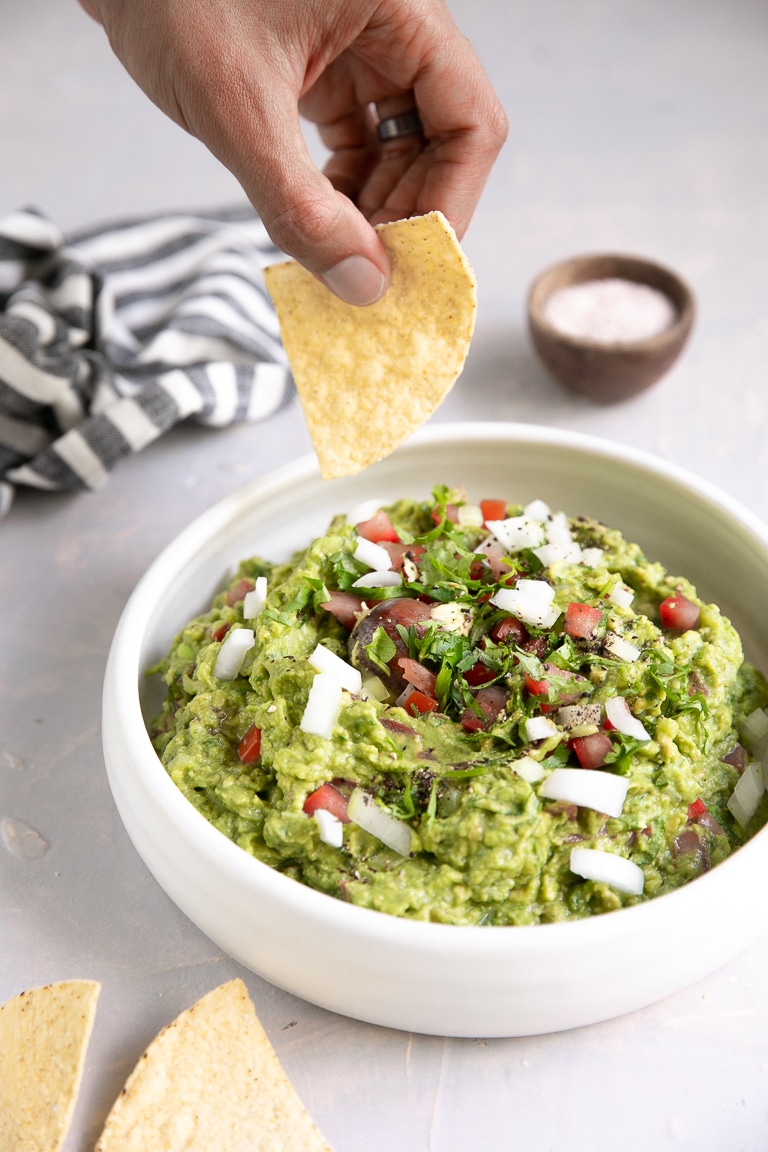
RECIPE CARD
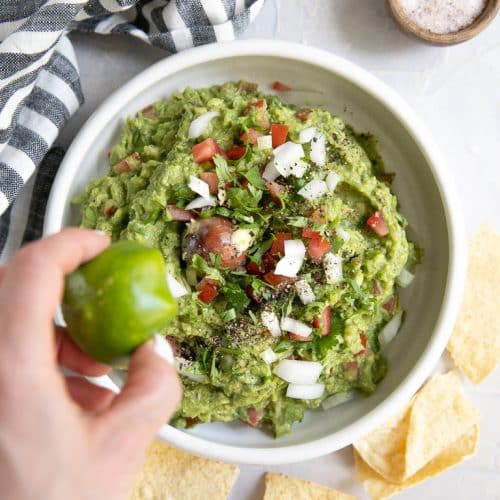
Guacamole Recipe
Ingredients
- 5 avocados - peeled, pitted, and mashed
- 2 limes - juiced
- 1 teaspoon salt
- ½ cup white onion - diced
- 2 Roma tomatoes - seeded and diced
- 1 clove garlic - minced
- ¼ cup fresh cilantro - chopped
- ½ teaspoon freshly ground black pepper
Instructions
- In a medium mixing bowl use a fork to mash together the avocado with the lime juice and salt until desired consistency is reached (smooth versus chunky).
- Mix in the diced onion, tomatoes, garlic, cilantro, and fresh ground black pepper. Stir to combine and season with additional salt, pepper, and lime juice, to taste.
Jessica’s Notes
Nutritional Information
(Nutrition information provided is an estimate and will vary based on cooking methods and specific brands of ingredients used.)

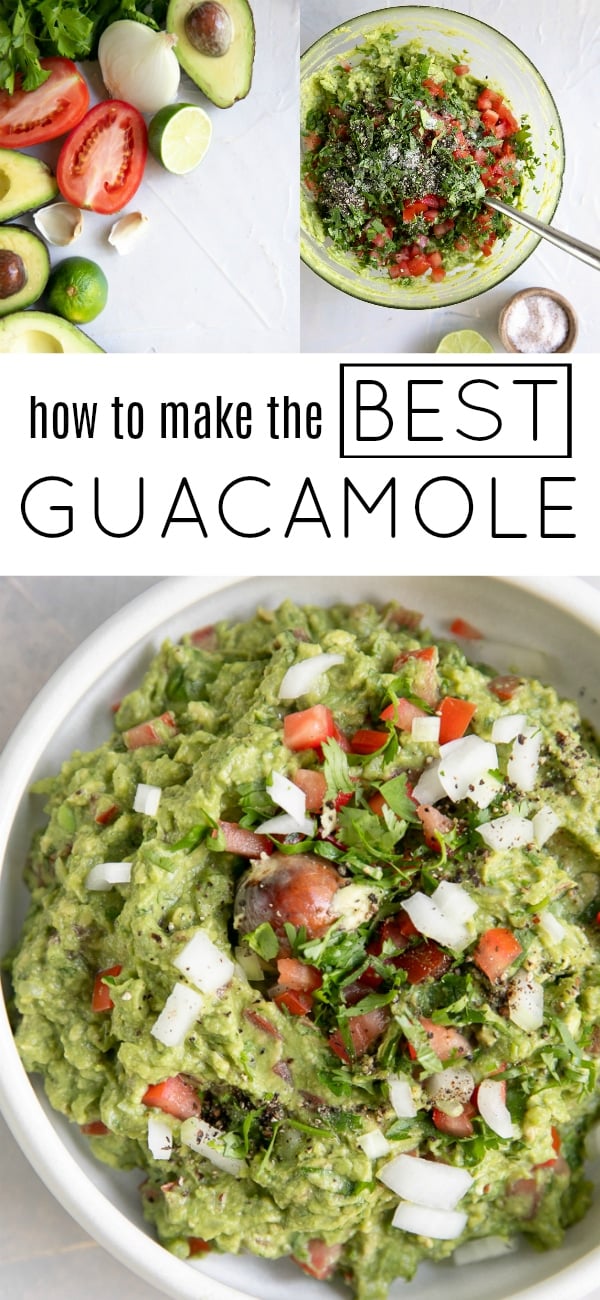


Last Updated | 0 Comments